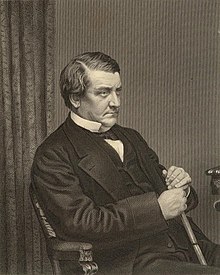Criminal Tribes Act
With the Criminal Tribes Act (CTA) or decree on public danger stems a Gesetzesgebung in is British India called, that had developed over several decades. It began in 1871 and was first used in northern Indian princely states . With the CTA, all nomadic peoples in the respective area of application were declared criminal. It gradually received amendments that were integrated into a single law in 1924 and became mandatory for more and more regions. After India became independent , the CTA was repealed.
The Governor General and Viceroy of India Richard Bourke, 6th Earl of Mayo , approved the CTA on October 12, 1871 as head of the British colonial administration there. The nomadic ethnic groups who found their livelihood with small trades and handicrafts as well as acrobats, dancers and musicians and who enjoyed a good reputation among the sedentary population were recorded in a register, viewed as criminals by nature and treated accordingly. Such peoples such as the Banjaras, Lambadis or Kuravas were only allowed to pursue their traditional way of life in certain areas, had to report to the police regularly and could be arrested without an enforcement warrant. Children between the ages of six and 18 were separated from their parents and placed in foster homes. She already had the ban under forest law, which existed before the CTA, to graze her cattle in the forests and collect bamboo and leaves there, and the increasing development of India by rail, which considerably restricted the demand for her services and products Years before 1871 increasingly marginalized .
At first it was only valid in the north Indian princely states such as B. Avadh , Khyber Pakhtunkhwa and what is now Uttar Pradesh . The CTA was introduced in Bengal in 1876 and most recently in Madras in 1911 . In 1947, when India gained independence and repealed the CTA, which Jawaharlal Nehru , India's first prime minister, called a disgrace to any civilized nation, 13 million Indians were under the surveillance of that law. Shortly thereafter, the CTA took a milder but similar content determination, instead Habitual Offenders Act or Decree habit perpetrators , the stigma continued population nomadic.
The motivation behind the issuance of the CTA is assessed differently. On the one hand, the biologism of the late 19th century with representatives such as Cesare Lombroso and his doctrine of the born criminal is blamed for this, others see it as a reaction of the colonial power, from whose point of view nomadism was not a legitimate means of livelihood, to the Indian uprising of 1857 , in which nomadic tribal leaders participated, especially in the north.
literature
- John Lancaster: Heading Nowhere . In: National Geographic Society (Ed.): National Geographic Germany . March 2010, p. 66-85 .
Web links
- Governor-General of India: Criminal Tribes Act, 1871. Act XXVII. (PDF) Google docs, October 12, 1871, archived from the original on January 13, 2012 ; accessed on May 19, 2011 (English).
Individual evidence
- ^ Governor-General of India: Criminal Tribes Act, 1871. Act XXVII. - Internet Archive October 12, 1871, p. 2 (English).
- ^ A b S. Viswanathan: Suspects forever. Members of the “denotified tribes” continue to bear the brunt of police brutality . In: Frontline. India's National Magazine . tape 19 , no. June 12 , 2002 (English, frontlineonnet.com ( Memento of November 12, 2011 in the Internet Archive )).
- ↑ a b Meena Radhakrishna: Dishonored by history . In: Sunday Magazine of The Hindu . July 16, 2000 (English, hinduonnet.com ( memento of April 24, 2011 in the Internet Archive )). Dishonored by history ( Memento of the original from April 24, 2011 in the Internet Archive ) Info: The archive link was automatically inserted and not yet checked. Please check the original and archive link according to the instructions and then remove this notice.
- ↑ a b Louis A. Knafla: Crime, gender, and sexuality in criminal Prosecutions . Greenwood Publishing Group, 2002, ISBN 0-313-31013-0 , pp. 124 ( books.google.com ).
- ↑ John Lancaster: On the Way to Nowhere . In: National Geographic Society (Ed.): National Geographic Germany . March 2010, ISSN 1615-0872 , p. 76 .
